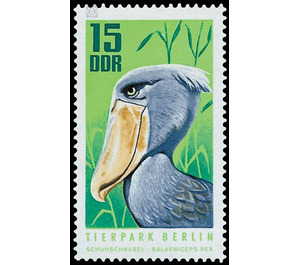Animal Park Berlin - Germany / German Democratic Republic 1970 - 15 Pfennig
Theme: Animals
| Country | Germany / German Democratic Republic |
| Issue Date | 1970 |
| Face Value | 15.00 |
| Color | grey green |
| Perforation | K 14 |
| Printing Type | Photogravure |
| Stamp Type | Postage stamp |
| Item Type | Stamp |
| Chronological Issue Number | 1360 |
| Chronological Chapter | GER-DDR |
| SID | 215285 |
| In 20 Wishlists | |
Berlin Zoo The Ministry of Posts and Telecommunications of the German Democratic Republic publishes four multicolored special postage stamps depicting various animals from the Berlin Zoo. Animals of Tierpark Berlin In the year 1970, Tierpark Berlin (founded August 27, 1954, opened July 2, 1955) is 15 years old. For this reason, the International Association of Directors Zoological Gardens holds its 25th Annual Meeting in Berlin-Friedrichsfelde. After twice stamp series of the GDR from Tierpark Berlin were inaugurated and helped to carry his name to all over the world, now again a set of four animals is to be issued, which brings particularly rare and attractive species to the representation. Each of the selected species has a special meaning for the zoo. It goes without saying that the choice of an animal park of around 5000 forms was not easy. 15-pfennig-Wert Shoebill, Balaeniceps rex J. Gd. Who once consciously saw a shoebill becomes this gracefully wading wading bird with his bright, penetrating eyes and the huge beak, which resembles a large wooden shoe, do not forget. The experts are not sure whether it is a stork or a heron. So he is put into his own family, the Shoebill (Balaencipitidae), whose only species he is. He is best reminded of a night heron as a twilight and nocturnal bird. His homeland are the impassable papyrus swamps of the White Nile, in Uganda and Katango, but where he is not common, is most likely to be found in pairs. So far we have only been poorly informed about his biology. He builds his nest in the swamp and covers it with two eggs. In the main, he eats shingeless and scale-poor fish, such as catfish and lungfish, but also small reptiles, amphibians and insects. The shoehorns of Tierpark Berlin are one of the many examples of the bond between the citizens of the GDR and the Tiergarten of the capital. They came to us as a precious gift from our trading mission in Karthum. These seemingly unapproachable birds can become quite tame to their keepers and greet them with shakes of their heads and beaks of beaks. Even after a long absence they recognize this again. The observations made on these impressive birds of passage inspired an employee of Tierpark Berlin, Inspector W. Fischer, to compose a monograph in the well-known "New Brehm Library".


